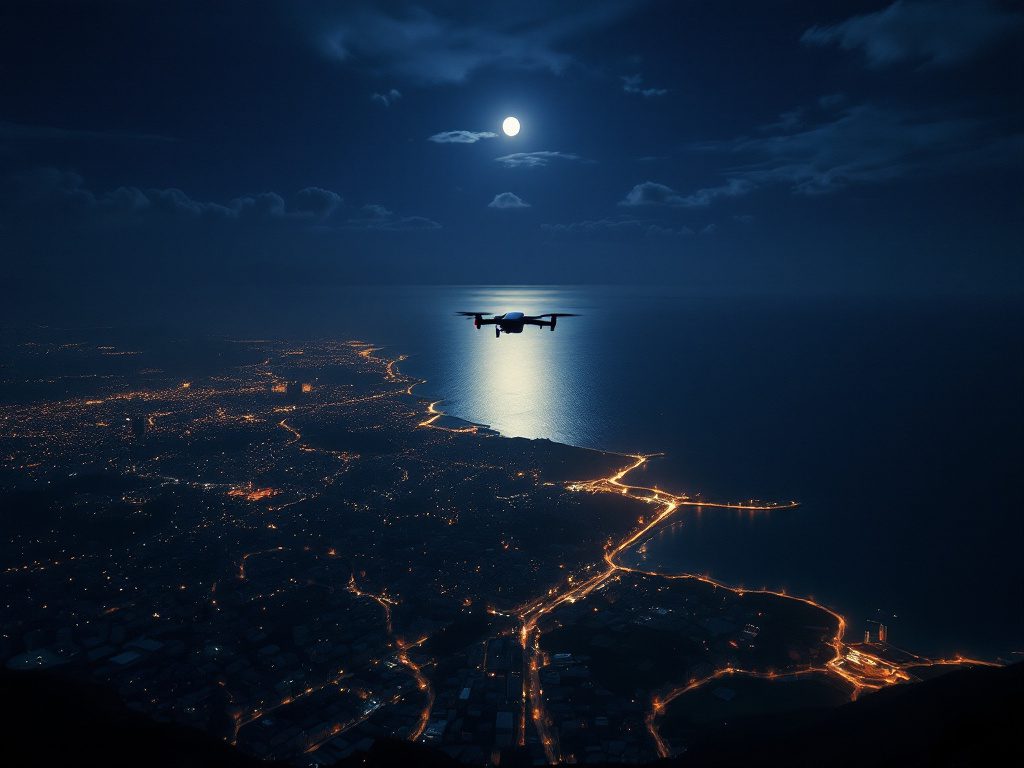The Night Crimea Lit Up: Drones and Defiance
Shortly after midnight on May 2, the sky over Crimea transformed into a theater of conflict, as more than 100 drones surged toward Russian-occupied military sites scattered across the peninsula. Reports reverberated through social media and monitoring channels, capturing not just the kaleidoscopic flashes of air defense volleys, but the echoing booms and staccato detonations that, for many, signaled something far more than routine. Explosions rolled through cities like Sevastopol, Dzhankoy, Saky, Novofedorivka, and Kacha—all crucial nodes in Russia’s Black Sea military infrastructure. Scenes like these—once unimaginable in what Kremlin officials had insisted was a secure, impenetrable bastion—punctuated a night of growing vulnerability for Moscow’s occupation.
The official Kremlin line, delivered through the voice of Sevastopol’s Russian-installed governor and the ever-cautious Russian Ministry of Defense, was familiar: The strike was repelled, 121 drones were neutralized, and no serious damage or casualties resulted. Yet, search a little deeper and a patchwork of narratives unfolds. Surveillance channels like “Crimean Wind” posted thick plumes of smoke and the crackle of secondary explosions, especially near weapons depots—“detonating ammunition,” in the language of witness-video analysts. Traffic on the strategically vital Kerch Bridge ground to a halt for hours, a jarring disruption to both military logistics and the mythos of an unassailable Russia.
Why the relentless focus on Crimea? Ukrainian officials, though silent on the record, have repeatedly championed the “demilitarization” of Crimea as essential for enduring security in the wider Black Sea region. For Kyiv and its Western backers, the peninsula embodies both a strategic and symbolic prize—wrested from Ukraine in 2014, transformed into a bristling fortress, and now, ever more clearly, a persistent chink in Russia’s armor. The latest drone barrage does not just highlight the vulnerability of Russian military positions; it also signals the evolving nature of modern warfare, where cheap, agile drones challenge even heavily fortified positions.
Rattled Defenses and Russian Retorts
What stands out in this attack is not just its scale, but its breadth. According to Russia’s Defense Ministry, drones were intercepted over Crimea, the Black Sea, and as far afield as Krasnodar, Oryol, Bryansk, and Belgorod. The air raid alert in Sevastopol stretched from 2:38 a.m. to 4:54 a.m., suggesting panic and urgency persisted longer than state narratives might admit. Russian forces declared “full combat readiness” west of the Crimean Bridge—an action that, while packaged officially as calm determination, reads much more like unease.
Scrutiny of Russian statements and local video reports—some showing fires near Kacha airfield—undercuts the official blandishments of total success. If, as Russia insists, its multi-layered air defense shield is nearly impenetrable, why do these attacks continue to sow so much chaos, forcing bridge shutdowns, panic orders, and the unmistakable sound of detonating stockpiles?
Recent episodes like these have prompted Western analysts to question the narrative of Russian invulnerability. Dr. Olga Oliker, Program Director for Europe and Central Asia at the International Crisis Group, notes, “Crimea’s vulnerability to sustained attacks is an indicator of where the tide of technological innovation and persistent Ukrainian resolve is pushing this conflict.” While Russia’s formidable S-400 air defense systems do succeed in downing many drones, saturation techniques and unpredictable flight paths mean the cost of defending Crimea rises with every new barrage. Russian authorities are quick to emphasize their success in intercepting attacks—but the psychological effect of repeated disruptions, sleepless nights, and the recurring threat to critical infrastructure cannot be airbrushed away.
“The facade of ‘fortress Crimea’ is under strain. Each drone that gets close exposes Russia’s limits and Ukraine’s growing strategic boldness.”
Beyond that, there’s a mounting sense that the old rules of the game—where tanks and missile silos determined outcomes—are being upended. The proliferation of drones, their effectiveness in disabling expensive assets, and their ability to slip through gaps in radar coverage are not just tactical innovations. They represent a paradigm shift, tilting the cost calculus and narrative leverage against an occupying force intent on projecting confidence and control.
What’s at Stake: Crimea, Control, and the Future of Warfare
Behind the headlines, the realities for Crimean civilians grow ever more complex. The peninsula’s nightmarish “normal”—the shuffle between everyday life and sudden emergency alerts—echoes grim historical parallels. Think of London’s Blitz or Israel’s experience with rocket fire: Supposedly bulletproof home-fronts are fractured by modern instruments of war, and morale—not just munitions—emerges as a front line.
Russia’s persistent attempts to downplay the impact of these drone strikes speak to a regime wary of appearing weak. Yet, each new incident pierces the illusion of comprehensive control. The acknowledgment of bridge shutdowns, fires near airfields, and the unforced admission of mass drone attacks all combine to undermine Russia’s official narrative. From a Western, progressive vantage point, the significance extends far beyond military metrics. The defense of occupied Crimea is not only a contest of arms, but also a battle for the hearts and minds of those under occupation and of observers around the globe who see in Ukraine’s resilience a reaffirmation of the right to self-determination.
Looking ahead, what lessons emerge from this night of thunder in Crimea? First, technological ingenuity—coupled with steady international support—can tilt the balance against even the largest militaries. Second, information control may win some propaganda points in the short term, but it does not suppress the reality of drone-fueled insecurity that now marks Russia’s hold on the peninsula. Finally, the international community must grapple with the reality that “stability” imposed by force is as fragile as a single unmanned aircraft slipping past the watchful eye of a nervy defender.
As Ukraine continues to adapt and innovate in its campaign to reclaim its territory, the world should take note: The story of Crimea’s defense—and the tenacity of those who refuse to accept occupation—reminds us all that the arc of justice, though long, bends toward those willing to meet the future head on.

